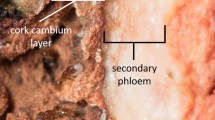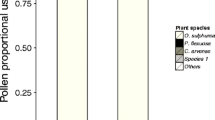Summary
In a montane Malayan rain forest, at an elevation of about 900 m above sea level, we found an undetermined and possibly undescribedDolichoderus species of thethoracicus group, living in colonies consisting of 50–100 silken pavilions on the undersides of leaves of different species of trees. Inside these pavilions, the ants kept scale insects, which we never found outside the nests on the colony tree. The stock of symbionts was actively regulated; supernumerary scale insects were thrown to the ground by the workers. New pavilions were colonized with scale insects. Our observations and behavioural experiments revealed that the silken material is produced by neither the brood nor the scale insects, but by the worker ants. This is the first proof of weaver ants outside the subfamily Camponotinae.
Similar content being viewed by others
References
Baroni Urbani, C., 1978. Materiali per una revisione deiLeptothorax neotropicali appartementi al sottogenereMacrosmischa Roger, n. comb. (Hymenoptera: Formicidae).Entomol. Brasil. 3:395–618.
Botz, T., P. Mattusch, und W. Hilgenberg, 1988. Methode zum Nachweis der Dauersporen des Kohlhernieerregers Plasmodiophora brassicae in gärtnerischen Kultursubstraten.J. Phytopathology 122:135–142.
Döhler, G., 1985. Effects of UV-B radiation on free amino acid pools of marine diatoms.Biochem. Physiol. Pflanzen 180:201–211.
Döhler, G., und J. Zink, 1984. Trennung freier Aminosäuren aus Extrakten von Meeresdiatomeen mittels Hochleistungs-Flüssigkeits-Chromatographie (HPLC). In:Königsteiner Chromatographie-Tage, pp. 208–220.
Finden, D., R. Fysh, and P. White, 1985. Quantitative method for the detection of glucose in body fluids by high-performance liquid chromatography with fluorescence detection.J. Chromatogr. 542:174–185.
Forel, A., 1905. Einige biologische Beobachtungen des Herrn Professor Dr. E. Göldi an brasilianischen Ameisen.Biol. Centralbl. 25:170–181.
Hölldobler, B., and E. O. Wilson, 1977. Weaver ants.Sci. Am. 237:146–154.
Hölldobler, B., and E. O. Wilson, 1978. The multiple recruitment systems of the African weaver antOecophylla longinoda (Latreille) (Hymenoptera: Formicidae).Behav. Ecol. Sociobiol. 3:19–60.
Hung, A. C., 1967. A revision of the ant genus Polyrhachis at the subgenus level.Trans. Amer. Ent. Soc. 93:395–422.
Jacobson, E., und A. Forel, 1909. Ameisen aus Java und Krakatau.Notes Leyden Mus. 31:221–253.
Karavajew, W., 1929. Die Spinndrüsen der Weberameisen (Hym. Formicid.). Zool.Anz. (Wasmann-Festband) 82:247–256.
Kovoor, J., 1977. La soie et les glandes sericigenes des Arachnides.Ann. Biol. T. XVI (3–4):97–171.
Kenchington, W., 1983. The larval silk ofHypera spp. (Coleoptera: Curculionidae). A new example of the cross-β protein conformation in an insect silk.J. Insect Physiol. 29:355–361.
Lawry, O. H., N. H. Rosebrough, A. L. Furr, and R. J. Raudall, 1951. Protein measurement with the folin phenol reagent.J. Biol. Chem. 193:265–275.
Lucas, F., J. T., Shaw, and S. G. Smith, 1957. Aminoacid composition of the silk ofChrysopa egg-stalks.Nature, Lond. 179:906–907.
Lucas, F., and K. M. Rudall, 1968. Extracellular fibrous proteins: the silks. In:Comprehensive Biochemistry 26B (M. Florkins and E. H. Stotz, Eds.). Elsevier Publishing Company, Amsterdam, pp. 475–558.
Maschwitz, U., K. Dumpert, and G. Schmidt, 1985. Silk pavilions of twoCamponotus (Karavaievia) species from Malaysia: description of a new nesting type in ants (Formicidae: Formicinae).Z. Tierpsych. 69:237–249.
Takeda, M., M. Maeda, and A. Tsuji, 1982. Fluorescence high performance liquid chromatography of reducing sugars using DNS-hydrazine as a pre-labelling reagent.J. Chromatogr. 244:347–355.
Reissig, J. L., J. L. Strominger, and C. F. LeLoir, 1935. A modified colorimetric method for the estimation of N-acetylamino sugars.J. Biol. Chem. 217:959–966.
Rudall, K. M., 1946. The structure of epidermal protein. Proc. Symp. in Fibrous proteins.Society of Dyers and Colouristics, Leeds: 15–20.
Schremmer, F., 1979a. Das Nest der neotropischen WeberameiseCamponotus (Myrmobrachys) senex Smith (Hymenoptera: Formicidae). Zool.Anz. 203:273–282.
Schremmer, F., 1979b. Die nahezu unbekannte neotropische WeberameiseCamponotus (Myrmobrachys) senex (Hymenoptera: Formicidae).Entomol. Gen. 5:363–378.
Wilson, E. O., 1981. Communal silk-spinning by larvae ofDendromyrmex tree-ants (Hymenoptera: Formicidae).Ins. Soc. 28:182–190.
Work, R. W., 1981. Web components associated with the major ampullate silk fibers of orb-web building spiders.Trans. Am. Microsc. Soc. 100(1):1–20.
Work, R. W., and C. T. Young, 1987. The amino-acid composition of major and minor ampullate silks of certain orb-web building spiders (Araneae, Araneidae).J. Arachnol. 15:65–80.
Author information
Authors and Affiliations
Additional information
After finishing the manuscript we found two further silk-weavingDolichoderus species with similar life-habits in Borneo. Both were polygynous and tended coccids in their pavilions on the underside of tree-leaves.
Rights and permissions
About this article
Cite this article
Maschwitz, U., Dumpert, K., Botz, T. et al. A silk-nest weaving Dolichoderine ant in a Malayan rain forest. Ins. Soc 38, 307–316 (1991). https://doi.org/10.1007/BF01314916
Received:
Revised:
Accepted:
Issue Date:
DOI: https://doi.org/10.1007/BF01314916




